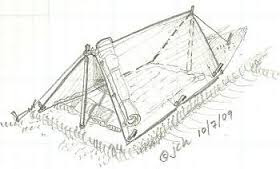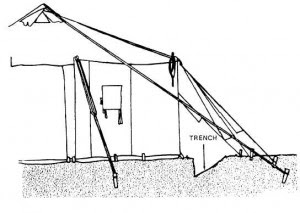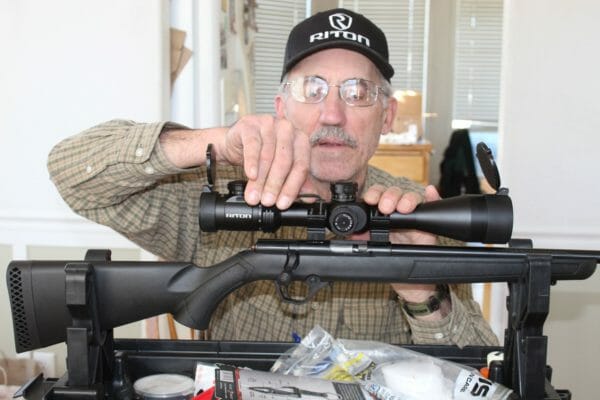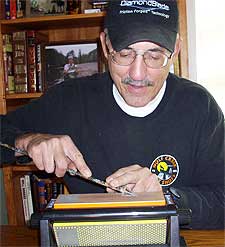Hong Kong Protests Show Dangers of a Cashless Society – Lesson: never allow any government to do away with cash.
A cashless society is a tyrant’s dream.


Here you can see the ditch going around the tent.
It has been raining hard on and off for the last several days. This resulted in a discussion about sleeping dry while camping in the rain. It’s surprising how little even experienced campers know about the subject, especially if they have generally camped during great weather or in drier locations. For them, the extent of their knowledge and preparedness comes down to depending on their tent alone to keep them dry.
Unless you want to end up with your gear soaked with water, soggy food, and wearing wet clothes, socks, and boots, here’s what you should know about sleeping dry.
There’s more to selecting a campsite than just a pretty view. You need to know how to How to Select a Campsite and have an understanding of how to build a drainage ditch around a tent if you suspect rain is in the forecast. Here are a few ideas to help you if you have to build a shelter in the rain and be sleeping dry even during a heavy downpour.
First, choose a high spot for your tent, and don’t pitch your tent in an indentation which will become a puddle if it rains. Make sure you have good drainage around your tent. Most newer tents are made tub-style, meaning the floor fabric comes up the wall several inches, even forming a lip at the door, with as few seams as possible. They claim that this will prevent water from coming into your tent even if you are sitting in a shallow puddle.
When we had tents without floors, the old-school style of directing rain away from your tent was to dig a ditch all around it. They tell me that this is no longer an acceptable practice for environmental reasons, and due to the style and materials of modern tents, no longer necessary.
I seriously question this, and in any type of a real survival situation, if rain is a problem, I will dig a shallow ditch around my tent and drain the water off to the downhill side. In the past, this method was taught by both the military and the boy scouts and is time-proven.
Personally, I’ve experienced a soaking wet tent, and it’s no fun. We have a Base Camp tent from REI, and although the overall quality is excellent, in no way is it waterproof, even with the rainfly if there’s enough rain.
So, if sleeping dry is a priority and rain is on the way, here’s how you can dig a drainage ditch around your tent.

Here you can see a cross-section of the ditch
Whether you are using a tent, tarp or another improvised shelter, if possible always point the opening downhill. If you live in an area that is subject to heavy rains and plan to camp out, have good tents and extra tarps.
If you look at the homeless camps during wet weather, most tents will have a tarp over them and often under them. If you put a tarp under your tent, be sure you fold the ends underneath so nothing is sticking out. If any part of the tarp is sticking out, it will funnel the water underneath your tent.
If you don’t have a sleeping pad or something to raise your sleeping bag off the ground, cut some brush or dry grass if it is available and put some padding between you and the ground.
If you live in an area that is subject to rainy weather, go camping in the rain. Try different types of shelters and see what works for you. Not too many years ago I went camping and used my old tent and a friend with me used his brand new 400 dollar tent. Guess which one leaked? The new one. Sleeping dry requires practice. Be sure and test your gear.
Disclosure: Some of the links below are affiliate links, meaning at no additional cost to you, Ammoland will earn a commission if you click through and make a purchase.

U.S.A. –-(Ammoland.com)- Rather than paying a gunsmith to mount your riflescope, I’d like to encourage you to mount your own! I am by no means maintenance inclined so if I can do it, anyone can. I am about to test some ground squirrel hunting rifles so while it is fresh on my mind, we’ll do this article on mounting a Riton Optics scope on one of those rifles.
For the Ground Squirrel Hunting articles, I’m testing Henry’s .22 mag and a Mossberg M817 .17 HMR and will be using Federal and CCI ammo. I hate to be old school, but it seems sacrilegious to put a scope on a lever action so we’re going to discuss mounting a Riton Optics RT-S MOD 5 6-24x50IR on the Mossberg M817. You may think that putting this nice of a scope on a rimfire rifle is a bit of an overkill but we’re going to be shooting small game and small varmints aren’t we? They have small kill zones so we need to be able to zero in on a small target.
Obviously, the first thing you must have is a base to mount your rings onto. Picatinny rails are super popular now and for a good reason. But this rifle came with some Weaver base mounts so that’s what I went with and I grabbed a set of Riton Optics rings.
When you buy rings, you have a few choices to make. First, does your scope have a 1-inch tube or a 30 mm tube? Next, if it has a larger objective, you may need higher rings. They make low, medium and high rings. You must have tall enough rings so the scope is not touching the barrel of your rifle but I like for my scope to be as close as possible to the barrel. I think they are more accurate that way.
Surprisingly, even though this Riton has a 50mm objective, I was able to use a “low” Riton Optics set of rings.
I’m sure that this will be a point of controversy, but I don’t always use Loctite when mounting a scope. Yes, on your magnums you should. Use the blue Loctite if you do decide to use it. That way it isn’t as permanent as some of the others.

I’m not saying it is impossible to mount one without a range box but it sure is a lot easier and more stable. I use a Universal Range Box by Otis Technology. I love it. Set it up and put in two-gun vises (Big V’s that hold your rifle steady).
As a kid, I’d prop my .22’s on a pile of blankets and wrestle with putting on a scope. Trust me; it’s a lot easier with the Otis Universal Range Box. You can do a better job plus you’re not as likely to drop a scope or rifle.
Next I screwed the Riton scope rings to the bases. This requires a size 12mm socket. After it is tight, remove the top half of the rings by using an Allan wrench. Lay the scope in the bottom rings and then apply the top rings and lightly screw in the screws. You want them loose. Now, look through the scope and make sure that the eye relief is set correctly. You want the scope positioned so that when you throw it up to shoot, that you don’t have to move your head forward or backwards to have full view through the scope.
Now that the eye relief is set, we need to make sure that the crosshairs are straight. They make levels to aid in doing so but I always just eyeball it. More than likely you’ll have to take the gun outside to set the eye relief and align the crosshairs.
When you have the above two items set, now it is time to tighten down the rings. Place the rifle back in the Otis Universal Range Box. You want to get your screws tight but don’t over tighten and strip them out. In extreme cases you could even warp the tube on a cheaper scope if you over tighten. To alleviate this from happening you can use a Brownell’s Magna-Tip Adjustable Torque Wrench to set how tight you screw it down.
About Tom Claycomb
Tom Claycomb has been an avid hunter/fisherman throughout his life as well as an outdoors writer with outdoor columns in the magazine Hunt Alaska, Bass Pro Shops, Bowhunter.net and freelances for numerous magazines and newspapers. “To properly skin your animal you will need a sharp knife. I have an e-article on Amazon Kindle titled Knife Sharpening for $.99 if you’re having trouble.”
 1. Forget about knives, bats, and fists. Bring a gun. Preferably, bring at least two guns. Bring all of your friends who have guns. Bring four times the ammunition you think you could ever need.
1. Forget about knives, bats, and fists. Bring a gun. Preferably, bring at least two guns. Bring all of your friends who have guns. Bring four times the ammunition you think you could ever need.
| August 27, 2015

A stroll in the woods is nearly always an enjoyable endeavor; what’s not so enjoyable is discovering a red, itchy rash the next day. Each year, millions of Americans come in contact with poison ivy, poison oak, or poison sumac. While there are numerous other poisonous plants, these three are grouped together because they share a common irritant: an oily resin/sap called urushiol. This resin is potent — it only takes 1 nanogram to cause a reaction. And unfortunately, it coats all parts of these plants.
While some of the characteristics we describe below aren’t necessarily unique to these plants, we’ll get you enough information to avoid these poisonous foes and confidently walk your favorite trails (or create your own!).
The old saying is true: “Leaves of three, let them be!” While there are other plants which have leaf clusters in threes, both poison ivy and poison oak share this trait, making it best to avoid plants with this feature altogether. What you’ll most likely encounter with poison ivy is a stem with a larger leaf at the end, and two smaller leaves shooting off the sides. The leaves can be notched or smooth on the edges, and they have pointed tips. The plant is reddish in the spring, green in summer, and yellow/orange in the fall. It’s not uncommon to see clusters of greenish-white berries on poison ivy through the spring and summer, as well as green/yellow flowers.




Poison ivy can take the form of a vine or a shrub. The plant’s appearance varies widely based on the region and specific environment where it grows, which is everywhere in the US with the exceptions of Hawaii, Alaska, and parts of the southwest deserts.
Like poison ivy, this plant most often grows leaves in clusters of three, although some varieties display five or seven per cluster. The defining feature is that the leaves have a lobed, wavy appearance (also described as scalloped), similar to oak tree leaves, but more subdued. Another characteristic that sets it apart from poison ivy is that the tips of the leaves are rounded rather than pointed. Its leaves are bright green in spring, turn yellow-green or pink in summer, and finally turn yellow into dark brown in the fall.



Poison oak is generally a shrub, averaging about 3 feet tall, but shoots of it can also grow as a vine. Not commonly found in the middle part of the U.S., poison oak is primarily situated on the West coast, and the East coast/Southeast.
Poison sumac stems (which are generally red — another of the defining features) have 7-13 leaves, in pairs, with a lone leaf at the end. Leaves are oval, elongated, and smooth-edged, usually 2-4 inches long. They are bright orange in spring, dark green in summer, and red-orange in fall.




Poison sumac thrives in watery, swampy environs, present mostly in the Midwest and Southeastern U.S., where high humidity is common. It grows as a tree or tall shrub, 5-20 feet tall.
An allergic reaction to poison ivy, oak, or sumac can occur when your skin makes direct contact with the plant, when you touch something that has been in contact with the plant, and even when the plant is burned, as particles of urushiol can make their way into your eyes, nose, and throat. Urushiol is very sticky and tenacious, so it easily adheres to firewood, dog fur, and gardening tools, and then transfers itself to your skin once you lift, pet, and pick up these things. Because urushiol is present in the plants’ roots, stems, and leaves, it remains potentially poisonous even in the wintertime.
Anyone can get an allergic reaction if exposed to urushiol in a large enough dose. But some folks are more sensitive than others. About 85% of the population is fairly to extremely susceptible to getting an allergic reaction, while 15% of lucky folks are resistant to reaction. One’s sensitivity/resistance is thought to be largely genetic in origin, so if your parents have had severe reactions to poisonous plants, take extra care to avoid contact yourself.
Sometimes you only get a rash after being exposed to the plant numerous times. So don’t automatically assume that you’re resistant because you touched poison ivy/oak/sumac once, and didn’t get a rash.
On the other hand, sensitivity to these poisonous plants can lessen over time. So if you had a bad reaction as a child, you may have developed more resistance over the years.
If you know you’ve touched one of these poisonous plants, you have about 10 minutes before the sap penetrates the lower layers of your skin and binds to its cells, at which point an allergic reaction will set in. So you can head off this reaction by immediately rinsing the exposed area with running water. Use a mild detergent soap if you have it; fatty soaps can spread the urushiol oil, creating a worse reaction. Rinsing with rubbing alcohol is also effective. If wipes are all you have to clean the area, that’s better than nothing.
If you don’t wash off the resin in time, and you’re sensitive to ivy/oak/sumac, then a rash will develop. Rashes from all three of these plants appear in the same form and are treated in the same way since the irritating agent in all of them is urushiol. If you’ve been outdoors and have the following symptoms appear, you may have a rash from one of these plants:
These are the primary symptoms, and they generally appear within 12-72 hours of contact. Luckily, if the rash isn’t severe, it can be treated at home without having to see a dermatologist.
The American Academy of Dermatology recommends the following treatment plan:
The rash should heal in about 1-2 weeks. Though it may look gross, it’s not contagious. If the rash is particularly large or painful, or doesn’t heal in that timeframe, it’s best to see a dermatologist who may prescribe a round of oral steroids or other treatments.
Above all, wearing long clothing when you go out is recommended — especially pants to guard against brushing these plants while wandering around. Be sure to wash these clothes right when you get home.
You’re now equipped to head out to the woods and avoid these itchy fiends!

What an idiot! Because you just know that Mommy Bear is close by and REALLY PISSED OFF!
___________________________________ Here is a little Tip in Field craft. In that Walt Disney’s world has nothing what so ever to do with the REAL WORLD. If you see any wild animal, Do Not Get Closer to it but instead put it in Reverse and get out of the Area.

Sighting in a rifle is an important thing to do if you want your rifle to be dead on when taking a shot.
Which brings us to the Carlos Hathcock way of sighting in a rifle.
For those that don’t know who Carlos Hathcock is, he was a United States Marine Corps (USMC) sniper with a service record of 93 confirmed kills.
Hathcock’s record and the extraordinary details of the missions he undertook made him a legend in the U.S. Marine Corps.
He was a serious threat to the NVA (North Vietnamese Army), which they placed a bounty of U.S. $30,000 on Hathcock’s head.
The following is a story by Gus Fisher a retired MGySgt USMC who talks of the time he met Carlos.
What was unique was the way Carlos had taught Gus to sight in a rifle. Here’s the excerpt from M14Forum:
As mentioned before, I was a very young Marine Sergeant when I came up to THE Marine Corps Rifle Team the first time as the junior Armorer.
I didn’t grow up using high power rifles. We used shotguns to hunt quail, rabbits, squirrels, pheasants, ducks and geese. I used a Mark I Ruger Target .22 pistol for racoon hunting and used a Model 74 Winchester .22 to really learn the basics of rifle marksmanship. My introduction to both high power shooting and long range shooting was in Marine Corps Boot Camp.
On Qual Day in Boot Camp, I ran 7 consecutive bullseye’s from the offhand position at 200 yards. The 8th round was a pinwheel bullseye, but it was on the target next to mine, so I got a maggie’s drawers. Knee High wind got me after that and I fell apart and only shot Sharpshooter in boot camp.
I bought a sporterized Mauser in .308 with a scope on it from a fellow Marine during the time I was going through the Armorer’s OJT program on Camp Pendleton. I used that for ground squirrel hunting, but was never really satisfied with my zero on the rifle.
So after I came up on “The Big Team,” I asked the second senior Armorer – Ted Hollabaugh, if he could show me how to REALLY sight in a rifle with a scope.
He said sure and he would do it, but since we had all the talent in the world at MTU, why didn’t I ask one of the shooters?
Well, I was a young kid and I didn’t know any of the shooters that well – most of them were much older than I. That’s when he suggested I ask Carlos Hathcock for some help.
I didn’t know Carlos then and did not know of his exploits in NM and Sniper shooting. Ted talked to Carlos about it and Carlos stopped by the shop later that afternoon.
Carlos looked at me and said, “So you want to sight in your rifle, eh? OK, thoroughly clean the bore and chamber. Dry the bore out with patches just before you come down to Range 4 tomorrow at noon on the 200 yard line. Have the sling on the rifle that you are going to use in hunting.” Then he went on about his business.
When I got to Range 4 the next day, he had a target in the air ready for me. He told me to get down in the best prone position I had. He checked me and adjusted my position just a bit. Then he said, “Before you shoot.
The MOST important thing I want you to do is take your time and make it the best shot possible. It doesn’t matter how long you take, just make it a good shot.
ALSO, and this is as important, make sure you give me an accurate call on where you think the bullet hit the target.” After I broke the shot, I told him where I thought the bullet had hit.
He checked it by using a spotting scope when the target came back up. He grinned just slightly and said, “not a bad call.” He then took a screwdriver and adjusted my scope a bit. He had me record everything possible about the shot and weather, humidity, temperature, wind, how I felt when the shot went off, what kind of ammo I was using, the date, and virtually everything about the conditions on the range that day.
I had never seen such a complete and precise recording of such things in a log book. He told me that if a fly had gone by the rifle and farted while I was shooting, to make sure I recorded that.
Then he told me to thoroughly clean the bore and chamber, and have it dry when I came back at 12 noon the next day. I was kind of surprised he only had me shoot once, but when you are getting free lessons – you don’t question or argue.
The next day, he told me the same thing. I called the shot and it was closer to the center of the bullseye. He made another slight adjustment and told me to clean the bore and chamber, dry the bore thoroughly and come back the next day at noon. Then we recorded everything possible about that day.
The following day, the shot was darn near exactly centered on the bullseye. Then he told me to clean and dry the bore before coming back the next day. Then we recorded everything about that day.
About a week into the process, Ted asked me how it was going. I said it was going really well, but we were only shooting one shot a day. Ted grinned and said, “How many shots do you think you are going to get at a deer? Don’t you think you had better make the first one count?” There was a level of knowledge and wisdom there that I immediately appreciated, though I came to appreciate it even more as time went on.
We continued this process with the sitting position at 200 yards, then prone and sitting at 300 yards and 400 yards. Then we went down to 100 yards and included offhand in the mix. Each day and each shot we recorded everything possible in the book and that included the sight settings for each position at each yard line. We also marked the scope adjustment settings with different color nail polish for each yard line.
When that was over after a few weeks, I thought I had a super good zero on the rifle. But no, not according to Carlos. He started calling me up on mornings it was foggy, rainy, windy, high or low humidity, etc., etc. and we fired a single shot and recorded the sight settings and everything else about the day. (I actually used four or five log books by the time we were through and put that info all into one ring binder.) I almost had an encyclopedia on that rifle. Grin.
Well, after a few months, we had shot a single round in most every kind of condition there was. Then about the 12th of December, it was REALLY cold and it seemed like an artic wind was blowing, there was about four inches of snow on the ground and freezing rain was falling. He called me up and told me to meet him at Range 4 at noon. I had gotten to know him well enough to joke, “Do you really want to watch me shoot in this kind of weather? He chuckled and said, “Well, are you ever going to hunt in this kind of weather?” I sighed and said, “See you at noon.”
By the next spring, I had records for sight settings for the first shot out of a “cold” barrel for almost any weather, position and range I would use and temperature/wind/humidity condition imagineable. He had informed me months before that was bascially how he wanted all Marine Snipers to sight in their rifles as only the first shot counts, though of course they would do it out to 700 yards on a walking target and further on a stationary target. They also practiced follow up shots, of course and we did some of that as well. It gave me great confidence that I could dial in my scope for anything I would come across.
Some years later in the late 90’s or really early this century, I was talking to a Police Sniper and he was really impressed I knew Carlos. I told him about the way Carlos had me sight in my rifle and suggested he do the same thing as he was a sniper for the Henrico Country SWAT team. He had never heard of that and took it to heart. About two and a half years later, he got called to a domestic situation where a husband had a handgun to his wife’s head and was going to kill her. After the Sergeant in charge and the Pysch guy determined the husband was really going to do it, the Police Officer was asked if he could hit the guy at just over 200 yards and not hit the wife. He said he knew he could (because he had followed Carlos method), so they told him to take the shot. One shot and the perp’s head exploded.
The wife was scared crapless, but unharmed.
When he told me about it about when I saw him the first time a week after the incident, the first thing I asked him if he was OK about taking the shot. He understood I was talking about the pyschological aspects and he really appreciated it. He said, it had bothered him a little that night until he remembered that if he had not taken the shot, the wife would have died. I checked back with him and he really was OK with having taken the shot. I’ve checked back every gun show I see him at and I know he is doing fine about it.
Sources: M14Forum